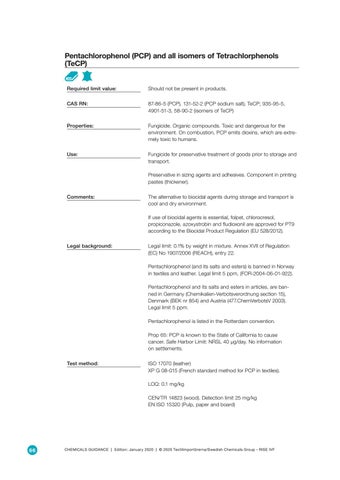Pentachlorophenol (PCP) and all isomers of Tetrachlorphenols (TeCP) Required limit value:
Should not be present in products.
CAS RN:
87-86-5 (PCP), 131-52-2 (PCP sodium salt), TeCP; 935-95-5, 4901-51-3, 58-90-2 (isomers of TeCP)
Properties:
Fungicide. Organic compounds. Toxic and dangerous for the environment. On combustion, PCP emits dioxins, which are extremely toxic to humans.
Use:
Fungicide for preservative treatment of goods prior to storage and transport. Preservative in sizing agents and adhesives. Component in printing pastes (thickener).
Comments:
The alternative to biocidal agents during storage and transport is cool and dry environment. If use of biocidal agents is essential, folpet, chlorocresol, propiconazole, azoxystrobin and fludioxonil are approved for PT9 according to the Biocidal Product Regulation (EU 528/2012).
Legal background:
Legal limit: 0.1% by weight in mixture. Annex XVII of Regulation (EC) No 1907/2006 (REACH), entry 22. Pentachlorophenol (and its salts and esters) is banned in Norway in textiles and leather. Legal limit 5 ppm, (FOR-2004-06-01-922). Pentachlorophenol and its salts and esters in articles, are banned in Germany (Chemikalien-Verbotsverordnung section 15), Denmark (BEK nr 854) and Austria (477.ChemVerbotsV 2003). Legal limit 5 ppm. Pentachlorophenol is listed in the Rotterdam convention. Prop 65: PCP is known to the State of California to cause cancer. Safe Harbor Limit: NRSL 40 µg/day. No information on settlements.
Test method:
ISO 17070 (leather) XP G 08-015 (French standard method for PCP in textiles). LOQ: 0.1 mg/kg CEN/TR 14823 (wood). Detection limit 25 mg/kg EN ISO 15320 (Pulp, paper and board)
66
CHEMICALS GUIDANCE | Edition: January 2020 | © 2020 Textilimportörerna/Swedish Chemicals Group - RISE IVF


